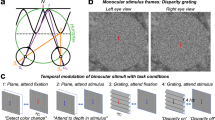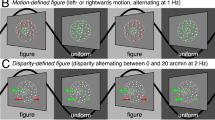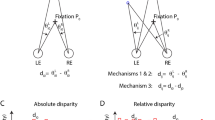Abstract
For binocular animals viewing a three-dimensional scene, the left and right eyes receive slightly different information, and the brain uses this 'binocular disparity' to interpret stereoscopic depth. An important theoretical conjecture in this mechanism is that coarse processing precedes and constrains finely detailed processing. We present three types of neurophysiological data from the cat's visual cortex that are consistent with a temporal coarse-to-fine tuning of disparity information. First, the disparity tuning of cortical cells generally sharpened during the time course of response. Second, cells responsive to large and small spatial scale had relatively shorter and longer temporal latencies, respectively. Third, cross-correlation analysis between simultaneously recorded pairs of cortical cells showed that connections between disparity-tuned neurons were generally stronger for coarse-to-fine processing than for fine-to-coarse processing. These results are consistent with theoretical and behavioral studies and suggest that rapid, coarse percepts are refined over time in stereoscopic depth perception.
This is a preview of subscription content, access via your institution
Access options
Subscribe to this journal
Receive 12 print issues and online access
$209.00 per year
only $17.42 per issue
Buy this article
- Purchase on Springer Link
- Instant access to full article PDF
Prices may be subject to local taxes which are calculated during checkout






Similar content being viewed by others
References
Wheatstone, C. Contributions to the physiology of vision. Part the first: on some remarkable and hirtherto unobserved phenomena of binocular vision. Phil. Trans. R. Soc. Lond. 128, 371–394 (1838).
Anzai, A., Ohzawa, I. & Freeman, R.D. Neural mechanisms for processing binocular information I. Simple cells. J. Neurophysiol. 82, 891–908 (1999).
Anzai, A., Ohzawa, I. & Freeman, R.D. Neural mechanisms for processing binocular information II. Complex cells. J. Neurophysiol. 82, 909–924 (1999).
Ohzawa, I., DeAngelis, G.C. & Freeman, R.D. Encoding of binocular disparity by complex cells in the cat's visual cortex. J. Neurophysiol. 77, 2879–2909 (1997).
Marr, D. & Poggio, T.A., computational theory of human stereo vision. Proc. R. Soc. Lond. B Biol. Sci. 204, 301–328 (1979).
Wilson, H.R., Blake, R. & Halpern, D.L. Coarse spatial scales constrain the range of binocular fusion on fine scales. J. Opt. Soc. Am. A 8, 229–236 (1991).
Fleet, D.J., Wagner, H. & Heeger, D.J. Neural encoding of binocular disparity: energy models, position shifts and phase shifts. Vision Res. 36, 1839–1857 (1996).
Rohaly, A.M. & Wilson, H.R. Nature of coarse-to-fine constraints on binocular fusion. J. Opt. Soc. Am. A 10, 2433–2441 (1993).
Anderson, C.H. & Van Essen, D.C. Shifter circuits: a computational strategy for dynamic aspects of visual processing. Proc. Natl. Acad. Sci. USA 84, 6297–6301 (1987).
Nishihara, H.K. Practical real-time imaging stereo matcher. Opt. Eng. 23, 536–545 (1984).
Nomura, M. A model for neural representation of binocular disparity in striate cortex: distributed representation and veto mechanism. Biol. Cybern. 69, 165–171 (1993).
Quam, L.H. Hierarchical warp stereo. in Readings in Computer Vision (eds. Fischler, M.A. & Firschein, O.) 80–86 (Kauffman, Los Altos, California, 1987).
Smallman, H.S. Fine-to-coarse scale disambiguation in stereopsis. Vision Res. 35, 1047–1060 (1995).
Smallman, H.S. & MacLeod, D.I. Spatial scale interactions in stereo sensitivity and the neural representation of binocular disparity. Perception 26, 977–994 (1997).
Sanger, T.D. Stereo disparity computation using gabor filters. Biol. Cybern. 59, 405–418 (1988).
Qian, N. & Zhu, Y. Physiological computation of binocular disparity. Vision Res. 37, 1811–1827 (1997).
Ohzawa, I., DeAngelis, G.C. & Freeman, R.D. Stereoscopic depth discrimination in the visual cortex: neurons ideally suited as disparity detectors. Science 249, 1037–1041 (1990).
Press, W.H., Teukolsky, S.A., Vetterling, W.T. & Flannery, B.P. Numerical Recipes in C (Cambridge Univ. Press, Cambridge, UK, 1992).
Ringach, D.L., Hawken, M.J. & Shapley, R. Dynamics of orientation tuning in macaque primary visual cortex. Nature 387, 281–284 (1997).
Bredfeldt, C.E. & Ringach, D.L. Dynamics of spatial frequency tuning in macaque V1. J. Neurosci. 22, 1976–1984 (2002).
Mazer, J.A., Vinje, W.E., McDermott, J., Schiller, P.H. & Gallant, J.L. Spatial frequency and orientation tuning dynamics in area V1. Proc. Natl. Acad. Sci. USA 99, 1645–1650 (2002).
Pack, C.C. & Born, R.T. Temporal dynamics of a neural solution to the aperture problem in visual area MT of macaque brain. Nature 409, 1040–1042 (2001).
Parker, D.M., Lishman, J.R. & Hughes, J. Evidence for the view that temporospatial integration in vision is temporally anisotropic. Perception 26, 1169–1180 (1997).
Rohaly, A.M. & Wilson, H.R. Disparity averaging across spatial scales. Vision Res. 34, 1315–1325 (1994).
DeAngelis, G.C., Ohzawa, I. & Freeman, R.D. Spatiotemporal organization of simple-cell receptive fields in the cat's striate cortex. I. General characteristics and postnatal development. J. Neurophysiol. 69, 1091–1117 (1993).
Li, G. Robust regression. in Exploring Data Tables, Trends and Shapes (eds. Hoaglin, D.C., Mosteller, F. & Tukey, J.W.) 281–340 (Wiley, New York, 1985).
Moore, G.P., Segundo, J.P., Perkel, D.H. & Levitan, H. Statistical signs of synaptic interaction in neurons. Biophys. J. 10, 876–900 (1970).
Perkel, D.H., Gerstein, G.L. & Moore, G.P. Neuronal spike trains and stochastic point processes. II. Simultaneous spike trains. Biophys. J. 7, 419–440 (1967).
Alonso, J.M. & Martinez, L.M. Functional connectivity between simple cells and complex cells in cat striate cortex. Nat. Neurosci. 1, 395–403 (1998).
Aertsen, A.M. & Gerstein, G.L. Evaluation of neuronal connectivity: sensitivity of cross-correlation. Brain Res. 340, 341–354 (1985).
Acknowledgements
This work was supported by research and CORE grants (EY01175 and EY03716) from the National Eye Institute. We gratefully acknowledge the use of data collected by I. Ohzawa and A. Anzai.
Author information
Authors and Affiliations
Ethics declarations
Competing interests
The authors declare no competing financial interests.
Rights and permissions
About this article
Cite this article
Menz, M., Freeman, R. Stereoscopic depth processing in the visual cortex: a coarse-to-fine mechanism. Nat Neurosci 6, 59–65 (2003). https://doi.org/10.1038/nn986
Received:
Accepted:
Published:
Issue Date:
DOI: https://doi.org/10.1038/nn986
This article is cited by
-
Realization of real-time X-ray stereoscopic vision during interventional procedures
Scientific Reports (2018)
-
Joint Image Denoising and Disparity Estimation via Stereo Structure PCA and Noise-Tolerant Cost
International Journal of Computer Vision (2017)
-
Development of spatial coarse-to-fine processing in the visual pathway
Journal of Computational Neuroscience (2014)
-
Look at the big picture (details will follow)
Nature Neuroscience (2003)



